
Late 19th Century Windsor Armchair in Oak with Spindleback
Windsor armchair, late 19th century in oak. Spindleback with captain's wheel splat and stretcher base with splayed turned legs. Height 118 cm, width 67 cm, depth 62 cm.

Pair of Elm and Ash Windsor Chairs, East Anglia, 1800
A matched pair of elm and ash Windsor chairs, East Anglia, circa 1800, of typical form with a pierced splat above the solid seat, on turned legs., height 90 cm

Late 19th Century Elm Windsor Chair with Wheel Back Splat
An elm Windsor chair, late 19th century the arched back with wheel backed splat and plain spindles to curvaceous arms, a saddle seat and raised on splayed turned legs united by plain stretchers.

1860 English Windsor Armchair with Elm and Fruitwood Provenance
An elm and fruitwood Windsor armchair, English circa 1860. Provenance: Allpress Antiques Melbourne 23/08/2009, 112 cm high, 66 cm wide, 47 cm deep

English Windsor Armchair, Elm and Fruitwood, Circa 1860, Provenance Melbourne
An elm and fruitwood Windsor armchair, English circa 1860. Provenance: Allpress Antiques Melbourne 23/08/2009, 112 cm 64 cm wide, 47 cm deep

19th Century Elm and Ash Windsor Chair with Pierced Back
A 19th century elm and ash country Windsor chair, with pierced and shaped splat back.

George III Yew and Burr Windsor Armchair with Pierced Splat
A good George III yew and burr timber Windsor armchair shaped and pierced splat, shaped seat, the bow stretcher with two supports. Good patina.

19th Century English Elm and Beech Windsor Chair, 92cm High
An antique English elm and beech Windsor chair, 19th century, 92 cm high, 60 cm across the arms

Pair of 19th Century Oak Windsor Chairs, 60 cm Wide
Pair of 19th century oak Windsor chairs 60 cm wide, 58 cm deep, 86 cm high
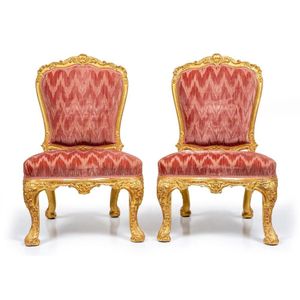
Gilt-Wood Side-Chairs from the Estate of the 10th Duke
A pair of carved gilt-wood side-chairs, ensuite to the previous lot. English circa 1820. Provenance: The 10th Duke of Argyll Inveraray Castle Scotland. Partridge, New Bond Street, London circa 1986. The Estate of Judith and Bruce Terry, Teychell, 16 Moule…

1820 English Carved Gilt-Wood Armchairs from Argyll Estate
A pair of exceptional carved and gilt-wood armchairs, English, circa 1820. English circa 1820. Provenance: From the collection of the trustees of the 10th Duke of Argyll Inveraray Castle Scotland. Partridge, New Bond Street, London circa 1986. The Estate…

Windsor Style Caned Carver Chair, 20th Century, Stained Wood
A small Windsor style caned carver chair, 20th century, the stained wood with an arched back and cross form wheel backed splats, with open curved arms to a caned seat, raised on cabriole front legs united by stretchers. Height 84 cm, width 55 cm, depth 55…

19th Century Oak & Elm Windsor Chair with Pierced Splat
Early 19th century oak & elm Windsor chair, traditional form with pierced central splat on turned legs and stretchers

Traditional Windsor Chair with Pierced Splat and Saddle Seat
Early 19th century elm Windsor chair, of traditional design with pierced central splat, saddle seat on turned legs and stretchers

18th Century Yew Wood Windsor and Hoop Back Chairs
A yew wood wheel back Windsor chair and a stretcher-based hoop back chair, 18th century
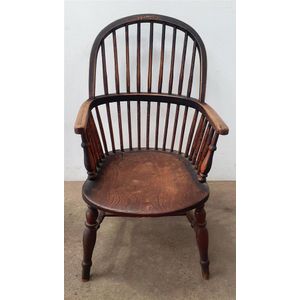
Bobbin-Legged Windsor Chair
An 18th/19th century ash and elm Windsor chair, with bobbin turned legs and stretcher. Height: 100 cm.

Antique Windsor Chair, 18th/19th Century
Child's antique Windsor chair, ash and elm, 18th/19th century, 72 cm high, 45 cm across the arms

Elm Windsor Armchair with Pierced Splat Back
An early 19th century elm Windsor armchair, pierced splat back, turned legs.

Mid 19th Century Elm Windsor Chair
An elm Windsor chair, mid 19th century, the hooped comb back with shaped and pierced splat above curved arms and the moulded seat, on turned supports with a crinoline stretcher, 111 cm high, 52 cm wide, 69 cm deep

Elm and Beech Windsor Chair, 19th Century
An elm and beech Windsor chair, second quarter 19th century, the straight comb back with toprail and curving arms, above the slab seat, on turned supports

Elm and Yew Windsor Chair with Crinoline Stretcher
A 19th century elm and yew Windsor chair, baluster legs joined by a crinoline stretcher,

Antique English Elm Windsor Chair - 104cm High
An antique English elm Windsor chair, 104 cm high, 56 cm across the arms

1850 Windsor Chairs with Rounded Backs and Turned Splats
A pair of Port Arthur Windsor chairs, circa 1850, with rounded backs and turned splats, raised on slightly splayed legs with pairs of stretchers

19th Century English Windsor Armchair
A classic yew-wood and elm Windsor armchair, English mid 19th century, 115 cm high 66 cm wide 47 cm deep

Elm Windsor Chairs with Provenance
Two Windsor chairs in elm' mid to late 20th century, each with a hooped back and a pierced splat, also having double tiered spindles, joined by flat arms to the saddle seat. The whole raised on turned legs joined by a crinoline stretcher. One chair has…
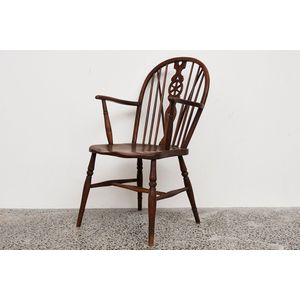
18th Century Windsor Yew Armchair
Windsor yew armchair, 18th century, with a pierced wheel back, height 94 cm. Provenance: Private Collection, NSW
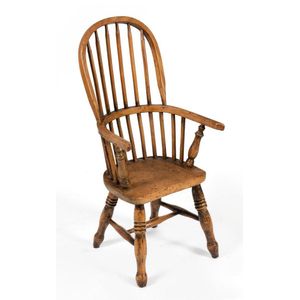
18th Century Child's Windsor Chair
An elm framed child's hoop back Windsor chair, 18th century, with saddle seat and splayed turned legs united by an 'H' form stretcher, 81 cm high, 49 cm wide, 35 cm deep

Elm Windsor Armchair with Hoop Back and Turned Details
An early 19th century elm hoop back Windsor armchair, turned arm supports, legs and stretchers. Of good colour, height 95 cm.

Elm Windsor Rocking Chair with Wheel Back
19th century Windsor rocking chair, in elm, with wheel back, height 106 cm
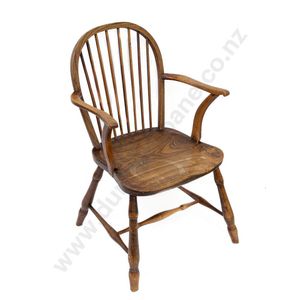
Antique Windsor Elbow Chair with Turned Legs
19th century oak and elm Windsor elbow chair arched stick back, saddle seat with turned legs and stretchers

19th Century English Windsor Armchairs
A pair of English Windsor armchairs, elm and beech, 19th century, 112 cm high, 51 cm across the arms

Elm Windsor Chairs with Low Backs and Turned Legs
A pair of 19th century elm low back Windsor chairs, shaped splat back, wide seats, turned legs. 52 x 48 x 90 cm.

Antique Elm Slat Back Windsor Chair
Antique Slat back Windsor chair, with elm wood seat, 59 cm wide, 63 cm deep, 108 cm high

Victorian Elm Windsor Carver Chair
An elm Windsor carver chair, Victorian, the arched back with wheel backed splat and plain spindles and incorporated 'U' shaped arms on a shaped seat on turned legs with plain stretchers, height 110 cm, width 56 cm depth 66 cm

Windsor Chairs with Saddle Seat and Spindles
Pair of Windsor chairs, 18th/19th century English oak and elm with saddled seat, shaped central back splat with spindles (with minor faults)

Victorian Windsor Chair with Arched Stick Back
A Victorian elm and beech Windsor chair, the typical arched stick back with pierced splat, the bowed back rail with spindle turned supports above a shaped solid seat on turned legs with turned stretchers, height 99 cm

Pair of 19th Century Windsor Chairs
Two mid 19th century Windsor chairs, with curved backs and spindles, above scrolled arms and shaped seat, raised on fluted and turned legs united by stretchers, one a/f, (2)

Georgian Windsor Chair with Cabriole Legs
A Georgian oak and elm comb back Windsor chair; Thames valley, the shaped top rail and baluster splat with stick uprights and curved back rail above a solid seat on cabriole legs with pad feet, joined by turned stretchers. Height 111 cm, width 63 cm,…

Elm Seat Windsor Chair by WMW
Slat back Windsor chair with elm seat and components, stamped WMW to back of seat, 61 cm wide, 68 cm deep, 116 cm high

Victorian ash and elm Windsor chair
A Victorian ash and elm broad arm Windsor chair, traditional central pierced slat back and spindles, turned uprights to the curving arms, raised on turned legs and stretcher base. 57 x 46 x 113 cm.

18th Century Windsor Armchair with Carved Splats
A fine English 18th century George III period ash and elm Windsor armchair. Having stick shaped splats with a carved central splat. Originally from the northern midlands of the UK.

Elm and Beech Windsor Chair, 19th Century
An elm and beech Windsor chair, first half 19th century, the arched comb back and u-shaped arms above a dished seat, on turned supports, joined with a H-form stretcher, 100 cm high, 55 cm wide, 58 cm deep.
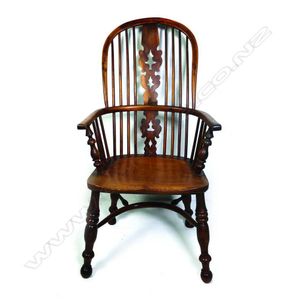
Victorian Elm Windsor Chair with Turned Legs
A Victorian elm Windsor chair, the traditional central pierced slat back and spindles, shaped seat, raised on substantial turned legs and curving stretcher base. 57 x 46 x 113 cm.

Georgian Elm Windsor Chair with Turned Legs
A Georgian elm Windsor chair, the traditional central pierced slat back and spindles, shaped seat, raised on turned legs and stretcher base. 55 x 42 x 103 cm.

Late 19th Century Windsor Armchair
Windsor armchair elm and yew, late 19th century, spindle back, height 112 cm

Late 19th Century Windsor Armchair
Windsor armchair elm and yew, late 19th century, spindle back, height 112 cm

Elm Windsor Chair with Pierced Splat and Turned Legs
19th century elm Windsor chair, with curved back and pierced centre wheel splat, surrounded by spindles, above a shaped seat raised on turned legs united by stretchers, maker's initials J.O.A to back, height 91 cm
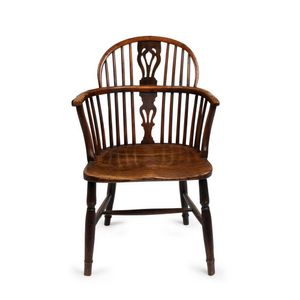
18th/19th Century English Windsor Chair with Low Back
An antique English Windsor chair with low back, elm, yew and beech, 18th/19th century, 85 cm high, 55 cm across the arms

19th Century English Windsor Armchair
An English antique Windsor armchair, elm and beech, 19th century, 111 cm high, 67 cm across the arms
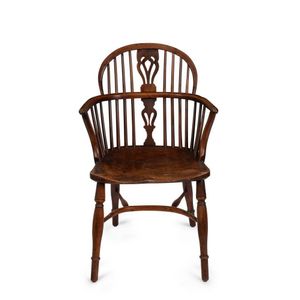
Antique English Windsor Armchair, Early 19th Century
An antique English Windsor armchair with crinoline stretcher, elm, yew and beech, early 19th century, 90 cm high, 57 cm across the arms
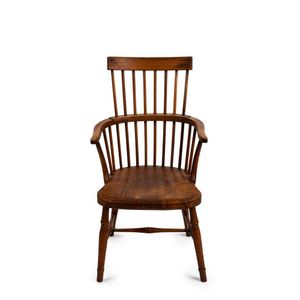
Antique Elm and Beech Windsor Chair
An antique English comb back Windsor chair, elm and turned beech, early to mid 19th century, 94 cm high, 51 cm across the arms

Antique English High Back Windsor Armchair
An antique English high back Windsor armchair, elm and beech with faded finish, early 19th century, 110 cm high, 71 cm across the arms

19th Century English Windsor Chair with Wood Worm Activity
An English Provinical elm and oak Windsor chair, 19th century, the arched crest rail, above pierced vertical splats and scrolls arms, and a contoured solid seat, raised on turned supports, 90 cm high, 47 cm wide, 41 cm deep, condition: evidence of…

Antique Oak Windsor Chairs with Columned Back and Legs
Pair antique oak Windsor chairs each with columned back and sides, to turned legs, height 87 cm; width 60 cm each.

Antique Windsor Dining Chair from Swanton Estate
An antique oak and elm Windsor dining chair, the arched back with central urn splat, the solid seat on turned legs and stretchers. Height 86 cm, width 44 cm, depth 49 cm. Provenance: from the contents of Swanton (built 1827), Sutton Forrest, NSW

Welsh Love Spoon Windsor Armchair, 1760
A magnificent Welsh comb backed Windsor armchair, with a 'Love Spoon' cresting rail above a shaped faw back and with an elm seat, Wealth Valley, circa 1760.

18th Century Goldsmith Windsor Armchair
An 18th century Goldsmith type Windsor fan back armchair, with a typical saddle shaped round seat a bobtail on turned legs and with 'H' stretchers.

19th Century Ash and Elm Windsor Chair
An ash and elm Windsor chair, the typical arched stick back with pierced splat, the bowed back rail with spindle turned supports above a shaped solid seat on turned legs with turned stretchers, 19th century, height 114 cm, width 67 cm, depth 60 cm

18th Century English Windsor Armchair
An English Windsor armchair, elm and beech, 18th century, 53 cm across the arms

Early 19th Century Windsor Armchairs
Pair of Windsor armchairs early 19th century elm and oak, bentwood back wth Spindles and, turned legs, British antique Deal Association sticker, height 101 cm

Traditional Elm Windsor Chair with Pierced Splat
George III elm Windsor chair traditional form with pierced central splat, baluster legs and crinoline stretcher

Traditional Elm Windsor Chair with Repairs
George III elm wheel back Windsor chair traditional form with baluster legs and stretchers (old repairs and chip to central splat)

Burr and Elm Windsor Chair with Turned Legs
An 19th century English burr and elm Windsor chair, spindle back, solid seat, raised on turned legs.
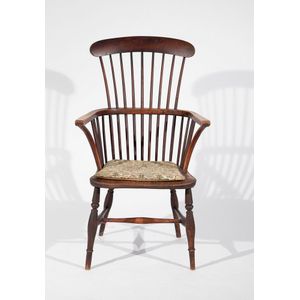
Traditional Windsor Chair with Turned Legs
George III elm and beech Windsor chair, traditional stick back form on turned legs and stretchers

Pierced Splat Windsor Chair in Elm and Beech
Elm and beech Windsor chair, with three pierced vertical splats on baluster legs and stretchers

English Elm Windsor Spindle Back Chair
A fine English elm Windsor spindle back elbow chair. Purchased Hoopers Fine Antiques High Street, Armadale, Melbourne.

Elm Windsor Chair with Vase Splat and Cross Base
An elm country Windsor chair plain spindles with central vase shaped splat, cross stretcher base. 48 x 38 x 91 cm.

Yew and Elm Windsor Chairs, Late 19th Century
Pair of Windsor chairs late 19th century, yew and elm, spindle and wheel back with, a stretcher base
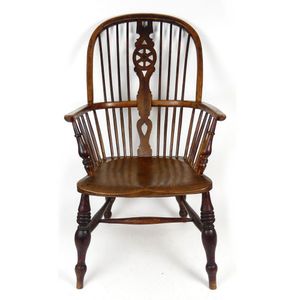
English Windsor Elbow Chair with Stick Back and Turned Legs
An 19th century English birch and elm Windsor elbow chair, stick back with wheel splat and turned legs.

Antique Oak Windsor Chair with Turned Legs and Arms
An 19th century oak Windsor type chair, the Windsor type back rest, pierced splats, out swept arms on turned supports and a shaped seat on turned legs with 'H' stretcher. English circa 1820. 110 x 70 x 65 cm

19th Century Oak Windsor Chair
A Windsor chair, in oak, 19th century, with curved back, above centre wheel splat, surrounded by spindles, on shaped seat raised on turned legs united by stretchers. Height 97 cm

Matched Oak and Elm Windsor Chairs
A group of charming matched oak and elm Windsor chairs, one stamped Nicholson Rockley, each of typical form with high back, 56 cm wide, 40 cm deep, 107.5 cm high

Elm Windsor Chair with Fleur De Lis Splat
19th century elm Windsor chair, central splat with oval fleur De lis, solid seat on turned legs and stretchers

Elm and Ash Windsor Armchairs with Carved Seats
19th century 2 Windsor style armchairs elm carved seats one with yew wood hoop and the other of ash-wood.

Georgian Windsor Chair with Pierced Back and Shaped Seat
A Georgian country elm Windsor chair, pierced back splats, shaped seat, stretcher base.

High Back Oak and Elm Windsor Chair
Windsor chair mid 19th century, high back in oak and elm, hoop back with enclosing Spindles and shaped pierced splat back, and slight Saddled seat, double stretcher base

Yew Wood Windsor Chair with Curved Back and Spindles
19th century Windsor chair, in yew wood, with curved back, above centre splat, surrounded by spindles, on shaped seat, on turned legs united by stretchers

Yew Wood Windsor Chair with Wheel Motif
19th century Windsor wheel back chair in yew wood, with curved back centre splat with wheel motif and flanked by spindles, arms on spindle supports shaped seat on turned stretchers united by stretchers

Stamped Elm Windsor Cottage Chairs with P.A. and St.Jp
Pair elm Windsor back cottage chairs, both with impressed stamp P.A. (Port Arthur) one with stamp St.Jp Womens Div (St Johns Park Womens division)

English Elm Windsor Chair with Hs Maker's Initials
An English elm Windsor chair, later 19th century, with maker's initials Hs, with a wide shaped cresting rail, lath back and shaped side frames to, curvaceous arms, a saddle seat with maker's initials to the rear, and raised, on raked and splayed turned…

Mid-19th Century Oak Windsor Armchair with Spindle Back
Oak Windsor armchair mid 19th century, spindle back

George III Windsor Armchair with Repairs
A George III Windsor armchair, similar to above, some later repair including shaped metal bars.

George III Windsor Armchair
A George III Windsor elm and beech armchair, the hoop back with pierced splat and 'cone' spindles, shaped elm seat, the turned legs with shaped stretchers.

Set of 4 Early 19th Century Wheel Back Chairs
A set of four yew and elm wheel back Windsor chairs, early 19th century, each with a curved stick-back centred on a shaped splat with wheel motif above the curved projecting arms, the moulded seat raised on splayed turned supports united with a crinoline…

English Elm and Yew Windsor Chair with Fleur-de-lis Back
19th century English elm and yew Windsor chair with a turned spindle back 'fleur-de-lis' shape above the out curved arms and solid seat, raised on turned legs joined by 'H' stretchers.

English Elm and Yew Windsor Chair with Turned Spindle Back
19th century English elm and yew Windsor chair with a turned spindle back 'wheel' shape above the out curved arms and solid seat, raised on turned legs joined by 'H' stretchers.
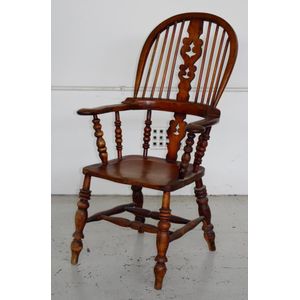

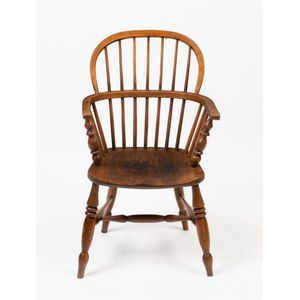







 Loading more...
Loading more...